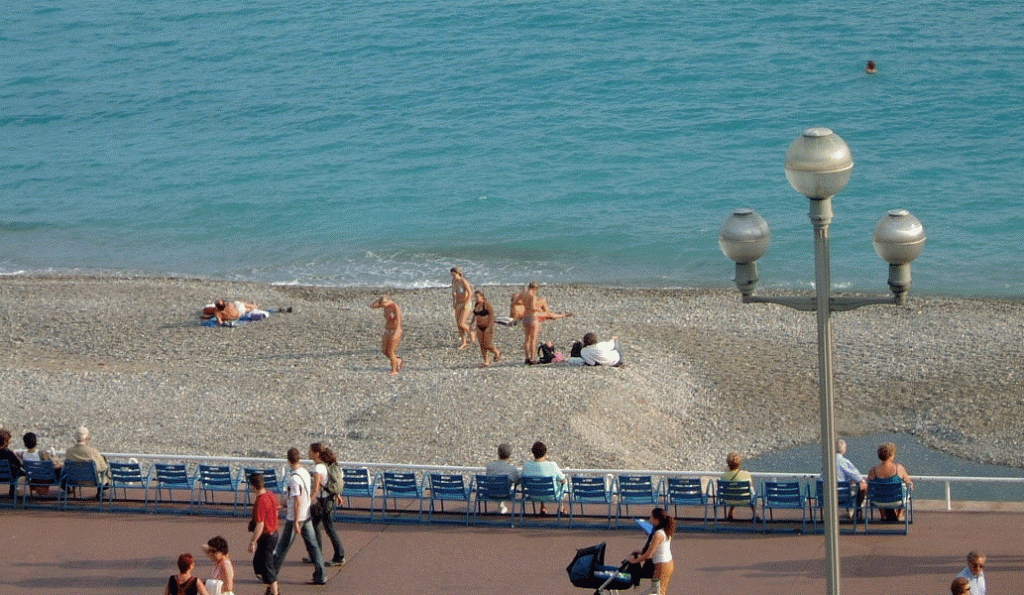A gentle breeze wafting through French balconies
overlooking the Promenade des Anglais…an aquamarine sea lapping
the shore of a glimmering stone beach…a canopied 4-poster bed flanked
by 17th century sconces and paisley linen walls…a bottle of champagne
shared with someone you love. Life doesn’t get much better than
that! For me, that paradisiacal life was at the Hotel Negresco
in Nice, France, the legendary palace hotel that has been my
French Riviera home-away-from-home for the past 3 decades.
 |
| HOTEL NEGRESCO |
wedding cake-like confection iced in pink and green, has been keeping a
silent vigil over the Promenade des Anglais for nearly a
century. Its magical name evokes a
certain joie de vivre and the carefree days of the Belle Epoque. The
elegant opulence of the Belle Epoque era is best exemplified
in the Salon Royal with its immense glass dome made in the
workshop of Gustave Eiffel, of Eiffel Tower fame.
Suspended from the dome of the Salon Royal is a Baccarat chandelier with
16,309 crystals. Weighing one ton, the chandelier is half of a pair
commissioned by the Czar of Russia at the end of the 19th century. In
direct juxtaposition to the chandelier is “The Nana
Jaune”, an obese, liberated, exuberant, brightly colored,
revolving sculpture by Niki de Saint Phalle.
 |
| SALON ROYAL IN NEGRESCO HOTEL |
various styles (from early Louis XV to late Louis Armstrong), has two
restaurants as fantastic and as varied as the hotel itself.
The moderately priced La Rotonde, affectionately dubbed “The
Disney World of the Hotel Negresco”, entertains diners with an
automated organ grinder pumping out tunes. Carrousel horses bob
up and down, as you relax and sip a Royal Negresco…a romantic blend
of Champagne, kirsch and raspberry syrup.
 |
| LA ROTONDE |
decorated with Regency-style, 18th century, oak wood panels and a
king’s ransom in art. The atmosphere is fit for royalty and so is the
food. The Menu Chantecler is a 6-course taste treat
guaranteed to please the most discriminating palate.
Dominating the Bay of Angels with its famous dome, the Hotel Negresco was
purchased in 1957 by Madame Jeanne Augier and her late husband
Paul. More than five decades later, Madame Augier still
supervises every facet of the world-renowned hotel that was classified as
a National Historic Monument by the French Government in 1974.
The Negresco is the crowning jewel of the Promenade des Anglais,
the Nicoise version of a bustling
boardwalk. Bright blue chairs invite strollers to rest their
weary feet and enjoy the passing parade of joggers, skaters, bikers,
and the cutest little dogs you’ve ever seen. The chairs on
the Promenade are free, but the seaside restaurants and chaise lounges
that dot the beach are pricey.
 |
| PROMENADE DES ANGLAIS OVERLOOKING THE MEDITERRANEAN |
In France, only Paris has more museums and galleries than Nice.
Three not-to-be-missed museums are the Chagall, the Matisse, and the
Museum of Modern and Contemporary Art.
The Musee National-Message Biblique Marc Chagall (1973), was one
of only two French museums ever dedicated to a living artist. A
sober structure, in a park-like setting surrounded by live oak,
cypress, and olive trees, the museum houses a collection of some
500-plus works of Chagall inspired by the Bible. Donated to France
by the artist, the collection includes a number of large paintings,
sculptures, stained glass mosaics, and wall tapestries.
Born in Russia in 1889, Chagall lived most of his life in France where he
claimed to “be born a second time”. Yet, in
spite of his French surroundings, the work of this forerunner of
surrealism was always stamped with his Russian-Jewish
roots. His subject matter, drawn from serious Jewish life
and folklore, was rendered with fairytale innocence.
The Matisse Museum is situated on the hill of Cimiez, not far from
the Gallo-Roman ruins and the Hotel Regina where the artist lived.
Since the 5th of January 1963 the Museum has been welcoming visitors
to its collection of works left by the artist (and his heirs) to the city
of Nice where he lived from 1918 until 1954.
Even if you don’t like contemporary art, the Museum of Modern and
Contemporary Art (Musee d’Art Moderne et d’Art Contemporain) is worth
a visit for the architecture alone. From its
arched terraces, you can get a panoramic view of the city.
Stroll through Nice’s famous Flower Market (Cours Saleya) in Old Nice
(Vieux Nice). It is packed with a plethora of
flowers, produce, restaurants, hip bars, and shops, where you can buy
Provencal goods. It operates six days a week. On Mondays,
it becomes a flea/antiques market.
The Rue de France Pedestrian Zone, or “zone
pietonne,” is another lively spot for shopping, dining, or just
plain people watching. Sit at a café, grab a slice of pizza
and watch the world go by.
 |
| PEOPLE-WATCHING AT LE CARROUSEL ALONG QUAI DES ETAS UNIS |
NICE (pronounced niece) is nice. Not only is Nice nice, it
is incredible! This haven, that temporarily removes one from reality,
is the reigning queen of the French Riviera (also known as the Cote
d’ Azur). If a portrait were to be painted of this queen of
resorts, it would have to include sea, sun, art,
architecture, history, culture, shopping, and some of the finest food in
the world.
Nice is Joie de vivre personified on the French Riviera!
STEINBERG is the winner of 40 national Travel Writer Awards and a Travel
Consultant with The Travel Authority in Mariemont, OH.
